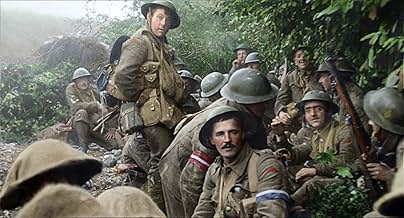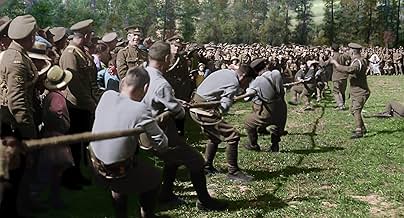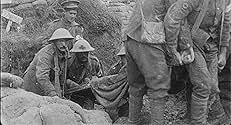IMDb RATING
8.2/10
40K
YOUR RATING
A documentary about World War I with never-before-seen footage to commemorate the centennial of the end of the war.A documentary about World War I with never-before-seen footage to commemorate the centennial of the end of the war.A documentary about World War I with never-before-seen footage to commemorate the centennial of the end of the war.
- Nominated for 1 BAFTA Award
- 6 wins & 14 nominations total
Thomas Adlam
- Self - Bedfordshire Regiment
- (voice)
- (as Capt Thomas Adlam VC)
William Argent
- Self - Royal Naval Air Service
- (voice)
- (as LM William Argent)
John Ashby
- Self - The Duke of Cambridge's Own (Middlesex Regiment)
- (voice)
- (as Cpl John Ashby)
Attwood
- Self - British Army
- (voice)
- (as Cpl Attwood)
Walter Aust
- Self - East Yorkshire Regiment
- (voice)
- (as Pte Walter Aust)
Donald Bain
- Self - Seaforth Highlanders
- (voice)
- (as Pte Donald Bain)
Thomas Baker
- Self - Chatham Battalion, Royal Naval Division
- (voice)
- (as Pte Thomas Baker)
George Banton
- Self - 50th Division Headquarters
- (voice)
- (as Sig George Banton)
Walter Becklake
- Self - Northhampyonshire Yeomanry
- (voice)
- (as L Cpl Walter Becklake MM)
Arthur Beeton
- Self - Royal Navy Air Service
- (voice)
- (as POM Arthur Beeton)
Robert Bell
- Self - British Army
- (voice)
- (as Mr Robert Bell)
William Benham
- Self - Hawke Battalion, Royal Navy Division
- (voice)
- (as Sub Lt William Benham)
Joseph Biglin
- Self - Durham Light Infantry
- (voice)
- (as Pte Joseph Biglin)
Edwin Bigwood
- Self - Worcestershire Regiment
- (voice)
- (as Pte Edwin Bigwood)
Horace Birks
- Self - Tanks Corps
- (voice)
- (as Capt Horace Birks)
Edmund Blunden
- Self - Royal Sussex Regiment
- (voice)
- (as Lt Edmund Blunden MC)
Clarence Bourne
- Self - Army Service Corps
- (voice)
- (as S Sgt Clarence Bourne)
Allan Bray
- Self - The Duke of Edinburgh's ((Whiltshire Regiment))
- (voice)
- (as L Cpl Allan Bray)
Featured reviews
I needed some time for this to sink in before commenting on it. This was equal parts funny, exciting, moving, harrowing, horrifying, upsetting.
Firstly, it's not a glossy documentary. There are some harrowing scenes in this that will, and should, upset you.
The first 25 minutes are of original black and white, speeded up footage with the original voices of troops telling their story over the top of it.
Then something amazing happens. The screen widens, the footage smoothes out, the colours shines through and in an instant your and seeing everything in so much more detail.
That said this was the first time I've seen footage from The Great War that didn't feel disconnected. It feels real. Seeing the colour on their cheeks and eyes, the dirt, the mud, the blood brings the old footage to life. Occasionally the colourisation takes on a slightly animated feel but never enough to draw you out of the engrossing scenes laid out before you.
Then the frame rate adjustment is amazing. Having computers generate the missing frames to adjust the variable 15-18fps to the regular 24fps is a visual butter knife that smoothes out the jerky footage.
Having the soldiers talk sounds like a mistake but it's done in such a subtle and sensitive way it never feels false. They've been lip synced perfectly and apparently even with the right accent for the infantry units depicted.
This was powerful viewing. Computers and technology being used for something so important, to allow 100+ year old footage to look so modern and yet not feel sanitised is amazing.
This should become compulsory viewing for every one, all schools too.
With footage thats this accessible there's no reason history should be forgotten.
Firstly, it's not a glossy documentary. There are some harrowing scenes in this that will, and should, upset you.
The first 25 minutes are of original black and white, speeded up footage with the original voices of troops telling their story over the top of it.
Then something amazing happens. The screen widens, the footage smoothes out, the colours shines through and in an instant your and seeing everything in so much more detail.
That said this was the first time I've seen footage from The Great War that didn't feel disconnected. It feels real. Seeing the colour on their cheeks and eyes, the dirt, the mud, the blood brings the old footage to life. Occasionally the colourisation takes on a slightly animated feel but never enough to draw you out of the engrossing scenes laid out before you.
Then the frame rate adjustment is amazing. Having computers generate the missing frames to adjust the variable 15-18fps to the regular 24fps is a visual butter knife that smoothes out the jerky footage.
Having the soldiers talk sounds like a mistake but it's done in such a subtle and sensitive way it never feels false. They've been lip synced perfectly and apparently even with the right accent for the infantry units depicted.
This was powerful viewing. Computers and technology being used for something so important, to allow 100+ year old footage to look so modern and yet not feel sanitised is amazing.
This should become compulsory viewing for every one, all schools too.
With footage thats this accessible there's no reason history should be forgotten.
Jackson's remarkable looking documentary is an amalgam of archive footage (much of it originally staged for the 1916 film 'The Battle of the Somme'), with only a tiny amount of actual battle footage given the early nature of film cameras in those days, plus the more moving sight of several of the soldiers staring and smiling into camera, and thanks to skillful lip-reading, speaking through interpreted voices.
The slowing down to our standard 24fps and adding of voices is beautifully touching. I personally don't know if it was essential to colourise as some of the greys in the originals are still visible, when uncolourised black and white footage is still just as immediate (the irony is that so many war films nowadays are drained of colour anyway.) Nonetheless, it is a vivid impression of life on the Western Front that Jackson helps to create, and remains refreshingly objective to its time, reflecting the general pro-war feelings at the beginning in 1914, and through carefully selected testimonies of the many hundreds of soldiers, unfolds the story of a kind of war that had never been seen before, or hopefully never will be again. Sadly humanity never learns its lesson, as the "war to end all wars" is now better known as World War I - all the more reason for history to remind us.
You watch this film, and in some of its more harrowing scenes you can see all the visual influence that Jackson drew upon for his Lord of the Rings trilogy. He dedicated this film to his grandfather who served in the war, and watching it , on the day after my own great grandfather's birthday (who also served in WWI), it was a thought provoking moment that stayed with me for a few hours after.
The slowing down to our standard 24fps and adding of voices is beautifully touching. I personally don't know if it was essential to colourise as some of the greys in the originals are still visible, when uncolourised black and white footage is still just as immediate (the irony is that so many war films nowadays are drained of colour anyway.) Nonetheless, it is a vivid impression of life on the Western Front that Jackson helps to create, and remains refreshingly objective to its time, reflecting the general pro-war feelings at the beginning in 1914, and through carefully selected testimonies of the many hundreds of soldiers, unfolds the story of a kind of war that had never been seen before, or hopefully never will be again. Sadly humanity never learns its lesson, as the "war to end all wars" is now better known as World War I - all the more reason for history to remind us.
You watch this film, and in some of its more harrowing scenes you can see all the visual influence that Jackson drew upon for his Lord of the Rings trilogy. He dedicated this film to his grandfather who served in the war, and watching it , on the day after my own great grandfather's birthday (who also served in WWI), it was a thought provoking moment that stayed with me for a few hours after.
As this historically important anniversary draws to a close, I just want to say that my viewing of this film was that of utter amazement. As a photo colouriser/restorer, I was absolutely astonished at the work PJ's team put into this. The transition from the original film material, then to the stabilised and corrected FPS and then the full colour and sound was one of the most spectacular things I have ever seen on the screen. The colour is natural and really helps emphasise the grittiness of war and brings out hidden details that may have been missed in the B&W source. Usually I prefer film not to be tampered with, but as Jackson says, this is how the men saw it - in living colour. The addition of the voiceovers from the surviving soldiers themselves is a great choice and doesn't distract and flows along nicely with the visuals. Throughout I expressed various emotions of sadness and shock, but surprisingly a few laughs, particularly one shot showing a soldier banging a tune on another soldiers helmet as they march.
I do wish I had seen this on the big screen and I imagine what I have said is enhanced 100x more with that type of viewing. A fitting tribute to the men that did and didn't come home and I hope it is recognised and picks up many awards.
Everyone over the age of 13 should be made to watch this.
This is simple exceptional work at every level from Peter Jackson and his team.
It showed the pure fragility of life, and how the soldiers dealt with it, mainly with humour and machine gun boiled tea.
It's haunting yet funny, disturbing yet uplifting. It's war. And this is the closest I ever want to come to it.
This is simple exceptional work at every level from Peter Jackson and his team.
It showed the pure fragility of life, and how the soldiers dealt with it, mainly with humour and machine gun boiled tea.
It's haunting yet funny, disturbing yet uplifting. It's war. And this is the closest I ever want to come to it.
A century later, Peter Jackson produced an informative and fascinating documentary about the First World War, seen by the English, in the trenches of the Bay of Somme, with dusted and colored archive images.
Almost everyone expected a brief and victorious war, which, as it was said at the time, would be "over at Christmas". The continuation was very different and became a trench war. Hygiene was deplorable until it became laughable but the atmosphere within the troops was fraternal despite the constantly oppressive atmosphere.
And we also learn that the English infantrymen regularly had a mission to capture a Fritz. Knowing that from a military strategy point of view, this is a complete nonsense, a war prisoner being systematically an useless and cumbersome dead weight, it is perhaps a pity that this documentary does not give to the audience an explicit explanation. And the only rational explanation is probably this one: to force the English infantrymen to attack the Germans, the prisoner of war being the proof of the effectiveness of their attack ...
Almost everyone expected a brief and victorious war, which, as it was said at the time, would be "over at Christmas". The continuation was very different and became a trench war. Hygiene was deplorable until it became laughable but the atmosphere within the troops was fraternal despite the constantly oppressive atmosphere.
And we also learn that the English infantrymen regularly had a mission to capture a Fritz. Knowing that from a military strategy point of view, this is a complete nonsense, a war prisoner being systematically an useless and cumbersome dead weight, it is perhaps a pity that this documentary does not give to the audience an explicit explanation. And the only rational explanation is probably this one: to force the English infantrymen to attack the Germans, the prisoner of war being the proof of the effectiveness of their attack ...
Did you know
- TriviaMuch of the footage had never been seen, having sat in the vaults of London's Imperial War Museum for many years.
- GoofsSeveral shots of tanks appear in the film, both Mark V (Mark Five) and Mark V* (Mark Five Star). They have been colourised green. In reality, tanks of these types were painted "a neutral brown colour". See the article by the British Tank Museum which states that. "Surrendering to the inevitable, towards the end of 1916 it was ordered that the tanks should be painted in a 'neutral brown colour' all over." These tanks entered service in 1918, and were factory-painted brown.
- Quotes
Soldier: [waving at camera] Hi, mum.
- Crazy credits"Filmed on location on the Western Front, 1914 to 1918"
- ConnectionsFeatured in Front Row: Episode #3.3 (2018)
- How long is They Shall Not Grow Old?Powered by Alexa
Details
- Release date
- Countries of origin
- Official sites
- Language
- Also known as
- They Shall Not Grow Old
- Filming locations
- Production companies
- See more company credits at IMDbPro
Box office
- Gross US & Canada
- $17,956,913
- Gross worldwide
- $21,656,913
- Runtime
- 1h 39m(99 min)
- Color
- Sound mix
- Aspect ratio
- 1.33 : 1(original footage)
- 1.85 : 1
Contribute to this page
Suggest an edit or add missing content



















